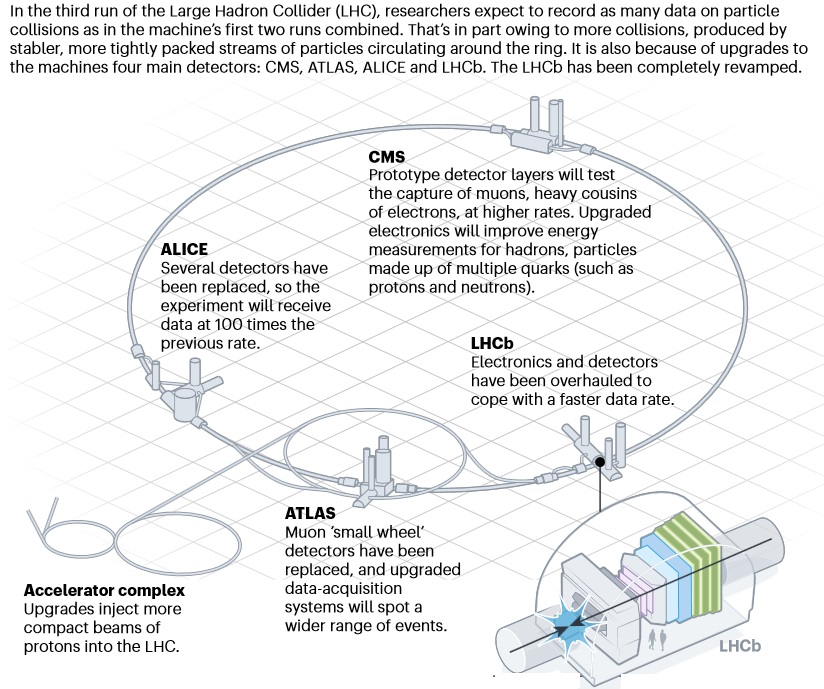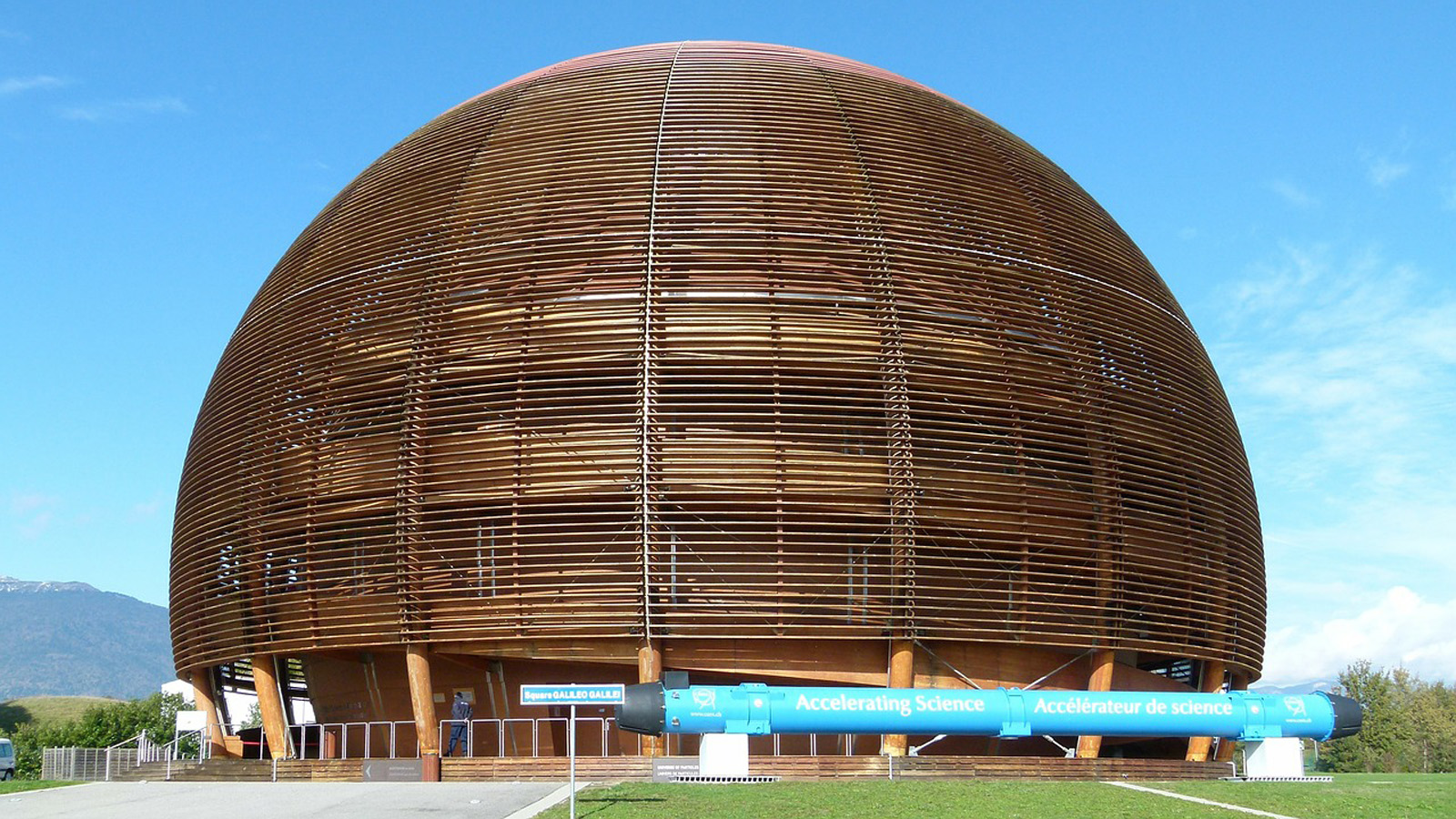Taking a closer look at LHC
The LHC detectors were designed, constructed and commissioned by international collaborations, bringing together scientists from institutes all over the world. In total, there are four large (ATLAS, CMS, LHCb and ALICE) and five small (TOTEM, LHCf, MoEDAL, FASER and SND@LHC) detectors (or experiments) at the LHC.
But the LHC family of experiments continues to grow. Alongside the four main experiments, a new generation of smaller experiments is contributing to the search for particles predicted by theories beyond the Standard Model. The FORMOSA demonstrator, which hunts for millicharged particles, has been installed in the cavern containing the FASER detector, 480 meters downstream from the ATLAS interaction point, the MilliQan detector, located 33 meters away from the CMS interaction point, and the CODEX-beta demonstrator in the LHCb cavern.
Other experiments, among them the proposed FASERν 2 and FLArE experiments, are under study and could start taking data when the high-luminosity LHC is switched on in 2029.
Considering that it took 20 years to plan and construct the detectors, and it's expected to last more than 20 years, the total duration of the experiments is almost equivalent to the entire career of a physicist.
The events (an event is a collision with all its resulting particles) are studied using detectors that are able to reconstruct what happened during the collisions - and to keep up with the enormous collision rates. Detectors can be compared to huge three-dimensional digital cameras that can take up to 40 million snapshots (with digitised information from tens of millions of sensors) per second. The detectors are built in layers, and each layer has a different functionality. The inner ones are the least dense, while the outer ones are denser and more compact.

The heavy particles that scientists produced in the LHC collisions are very short-lived, rapidly decaying into lighter, known particles. After a hard collision, hundreds of these lighter particles, for example electrons, muons and photons, but also protons, neutrons and others, fly through the detector at close to the speed of light. Detectors use these lighter particles to deduce the brief existence of the new, heavy ones.
The trajectories of charged particle are bent by magnetic fields, and their radius of curvature is used to calculate their momentum: the higher the kinetic energy, the shallower the curvature. For particles with high kinetic energy, therefore, a sufficiently long trajectory must be measured in order to accurately determine the curvature radius. Other important parts of a detector are calorimeters for measuring the energy of particles (both charged and uncharged). The calorimeters too have to be large enough to absorb as much particle energy as possible. These are the two principle reasons why the LHC detectors are so large. The detectors are built to hermetically enclose the interaction region in order to account for the total energy and momentum balance of each event and to reconstruct it in detail. Combining the information from the different layers of the detector, it is possible to determine the type of particle which has left each trace.
Charged particles – electrons, protons and muons – leave traces through ionisation. Electrons are very light and therefore lose their energy quickly, while protons penetrate further through the layers of the detector. Photons themselves leave no trace, but in the calorimeters, each photon converts into one electron and one positron, the energies of which are then measured. The energy of neutrons is measured indirectly: neutrons transfer their energy to protons, and these protons are then detected. Muons are the only particles that reach (and are detected by) the outermost layers of the detector.

Each part of a detector is connected to an electronic readout system via thousands of cables. As soon as an impulse is registered, the system records the exact place and time and sends the information to a computer. Several hundred computers work together to combine the information. At the top of the computer hierarchy is a very fast system which decides - in a split second - whether an event is interesting or not. There are many different criteria to select potentially significant events, which is how the enormous data of 600 million events is reduced to a few hundred events per second that are investigated in detail.
The texts above have been based in Landua R. (2008). "THE LHC: A LOOK INSIDE". Science in School Issue 10 : Winter 2008, pp 34-45.
Detectors Live
(Taken from MELTRONX ©2009-2024. A Real Frisco Kid Production Not Affiliated with CERN)
The construction of these detectors is the result of what could be called a ‘group intelligence’: while the scientists working on a detector understand the function of the apparatus in general, no one scientist is familiar with the details and precise function of each single part. In such a collaboration, every scientist contributes with his or her expertise to the overall success.
At each Long Shutdown (LS) the various accelerators, detectors and other devices are subject to major maintenance, consolidation and upgrade operations. The image below shows some of those performed on the largest detectors during LS2 (2019-2022).

[Image from Gibney E. (2022). Nature Vol 605, 604-607]
In each of the sections dedicated to each detector, the most important improvements carried out are indicated.
|
AUTHORS Xabier Cid Vidal, PhD in experimental Particle Physics for Santiago University (USC). Research Fellow in experimental Particle Physics at CERN from January 2013 to Decembre 2015. He was until 2022 linked to the Department of Particle Physics of the USC as a "Juan de La Cierva", "Ramon y Cajal" fellow (Spanish Postdoctoral Senior Grants), and Associate Professor. Since 2023 is Senior Lecturer in that Department.(ORCID). Ramon Cid Manzano, until his retirement in 2020 was secondary school Physics Teacher at IES de SAR (Santiago - Spain), and part-time Lecturer (Profesor Asociado) in Faculty of Education at the University of Santiago (Spain). He has a Degree in Physics and a Degree in Chemistry, and he is PhD for Santiago University (USC) (ORCID). |
CERN CERN Experimental Physics Department CERN and the Environment |
LHC |
IMPORTANT NOTICE
For the bibliography used when writing this Section please go to the References Section
© Xabier Cid Vidal & Ramon Cid - rcid@lhc-closer.es | SANTIAGO (SPAIN) |




